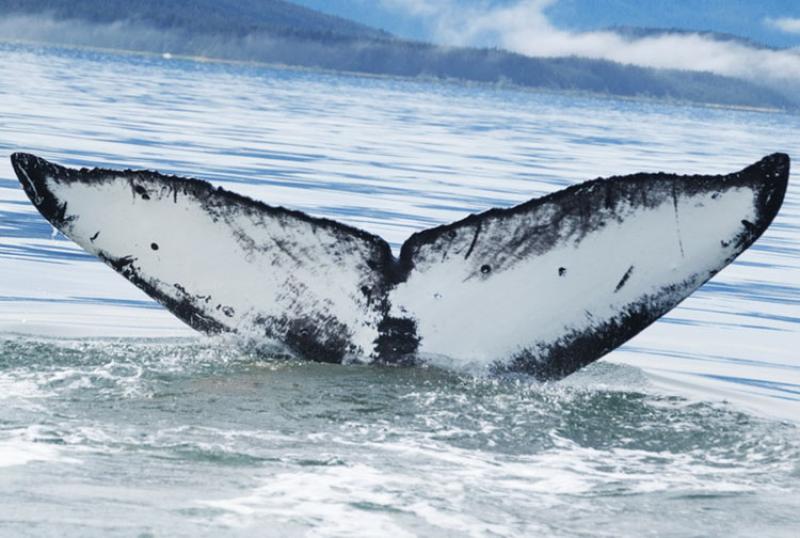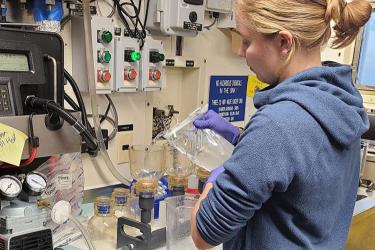The Journey of a Tail
To celebrate Whale Week (February 14-20, 2022), NOAA Fisheries is spotlighting a well-loved, school-bus-sized, seasonal resident of Juneau, Alaska—the humpback whale named Flame!
Flame was named by the whale-watching community and is one of the most frequently observed whales in Juneau. She’s also known as #1538 in the Southeast Alaska Humpback Whale Catalog. As a juvenile, she was first documented in 2004 by the University of Alaska Southeast as part of a broad collaborative study known as SPLASH. Flame is currently around 20 years old. She’s easily identified by her distinct markings: a prominent, sharply pointed dorsal fin and the white color and asymmetrical black markings on the underside of her tail. Scientists and the local whale-watching community use such markings to track the annual movements of humpback whales between summer and fall feeding grounds. In Flame’s case, this is the trip between Alaska and her winter breeding and birthing waters around the Hawaiian Islands.
Using photographs to identify whales and other species protected under the Marine Mammal Protection Act is beneficial to the scientific community. It allows for population assessments and longitudinal tracking of individuals which provides information that helps us understand and protect these animals. Humpback whales are identified by the underside of their tails, which are called flukes. Each pair of flukes is unique, making it easy to track individual whales. Photos of whale flukes are collected and cataloged as photo identification data.
Dr. Suzie Teerlink, NOAA Fisheries Marine Mammal Specialist, and John Moran, Alaska Fisheries Science Center Research Biologist, first started seeing Flame around Juneau in 2007. They were collecting fall and winter photo identification data of humpback whales. Since then, she has been a regular summer resident of Juneau. It wasn’t until Flame was seen off Maui during the 2019 breeding season by researchers from the Pacific Whale Foundation that we knew she wintered in the Hawaiian Islands. She was seen there again in 2020 by researchers from the Whale Trust.
“Flame is one of my favorites because she is so easy to work with,” said Moran. “She’s a great fluker with distinctive markings, so we always get a quick ID on her. That’s probably why she has a good sighting record.”
A Whale of a Mom
Flame was identified as female when she was seen with her first calf Spark in 2013; her second calf Ember followed in 2016.
“In 2019, the community was especially excited about the return of Flame and her new calf,” Teerlink said. “The Juneau area had seen a drop in humpback whale abundance and calf production following a marine heatwave in the Gulf of Alaska that impacted humpback whale prey availability. There hadn’t been many calves around Juneau in the years prior, and many felt that it was a good omen to have Juneau’s most popular whale return with a calf in tow. What we didn’t know is that this would be the start of an impressive calving streak.”
Most mature female humpback whales have calves only once every 2–4 years, although occasionally humpback whales will calve 2 years in a row. But Flame surpassed that by bringing three consecutive calves back to Alaska: Bunsen in 2019, Smoke in 2020, and Bolt in 2021.
But more exciting still, we learned that Flame was most likely pregnant, yet again, in 2021. If all goes well, she might return with a calf in 2022!
Her pregnancy status was predicted based on tissue samples taken as part of a collaborative research project studying Juneau-area humpback whales. The samples were recently analyzed in Dr. Shannon Atkinson’s lab at the University of Alaska Fairbanks (Juneau Campus). The project is led by Dr. Heidi Pearson of the University of Alaska Southeast, with Teerlink, Moran, and Atkinson as collaborators.
“The goal of this research is to collect baseline data on Juneau-area humpback whales during the unprecedented low tourism levels caused by the COVID-19 pandemic,” Pearson said.
The project is collecting photo identification and biopsy tissue samples. This will make it possible to measure and analyze steroid hormone levels to understand stress (cortisol) and pregnancy (progesterone), among other important markers.
“We were pleasantly surprised to see her elevated progesterone, reflecting her pregnancy, while she was still nursing last year’s calf!” said Dr. Shannon Atkinson, professor in UAF’s College of Fisheries and Ocean Sciences.
Successive calving of more than two years in a row is rare, and up to 4 successive calves is extremely rare. However, humpback whale calves have a 75 percent chance of surviving their first year of life, and so we can’t know for certain if she will arrive in Alaska with a calf in 2022. However, there is great anticipation that Flame will return to Juneau this summer with her sixth calf—an incredible feat!
Community Science Aids Sightings ... and Names Babies
Flame has been sighted countless times in Juneau. More than 229 of those sightings plus several sightings of her off Maui have been uploaded to Happywhale.com. Happywhale is a global research collaboration and citizen science web platform containing data on encounters of more than 66,000 individual humpback whales. The whale-watching community contributes invaluable data to the scientific field by sighting and tracking whales throughout their range. Organizations like Happywhale connect scientists, professionals,
enthusiasts, and the local community to contribute data on marine mammals. Happywhale also works to raise awareness about the ocean environment and the species within it through its creative online tracking platform. By empowering those who love whales to take part in their sightings, the community can enhance species data collection and protection efforts.
The small research and education nonprofit Juneau Flukes, run by Dr. Suzie Teerlink, curates a local Juneau catalog of humpback whales dating back to 2006. It also helps with sightings. Anyone can submit names for the cataloged whales and calves.
During 2019, the local community was buzzing with excitement about Flame’s new calf and eager to name the baby whale. Juneau Flukes held a competition to choose between the names Flicker and Blaze, which were neck and neck in the running. At the last minute, Teerlink threw in a third alternative, Bunsen (as in a Bunsen burner, which is a laboratory instrument), as a joke. Bunsen won the vote by a landslide and officially became the name of Flame’s 2019 calf.
Flame was most recently sighted near Juneau on December 1, 2021. At that time, she had not yet set south for her migration. The whale-watching community has followed this incredible mother over many years. NOAA Fisheries is looking forward to her return to Juneau waters this summer, hopefully with a new calf in tow.






